

Linda Pemik
Connected educator, College Administrator, wife, mother, grandmother who encourages creativity and respects our differences
84 Quick & Healthy Meals in Minutes! Cooking for better nutrition and weight management doesn't have to mean hours in the kitchen or complicated culinary techniques.

These meals and snacks, part of our 30-Day "Fit Food" Challenge, are quick, easy, and full of flavor! Here you'll find four weeks' worth of breakfasts, lunches and dinners, plus healthy snacks to round out your day. Depending on your hunger level and calorie needs, you can always adjust the portion sizes or add on with more snacks to meet your goals. 9 Wrong And 8 Right Ways Students Should Use Technology. Technology is a tool.

It’s not a learning outcome. Too often do we get distracted by all the activities and action we can perform with an iPad or some other device. Open Thinking Wiki. #etmooc Lip Dub! Well #etmooc, we’ve reached the end of our first topic, Connected Learning.
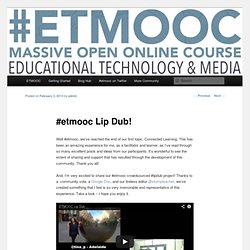
This has been an amazing experience for me, as a facilitator and learner, as I’ve read through so many excellent posts and ideas from our participants. It’s wonderful to see the extent of sharing and support that has resulted through the development of this community. Thank you all! My Bucket List. Key Theories You Need To Know From The World Of Social Science. The 18 Best Free Web Tools Chosen By You. It’s the start of a new year and that means there’s infinite possibilities that lay before you. But you can’t move forward without arming yourself with the best free web tools and apps. I was perusing some of my favorite education blogs, social networks, and other time-sucking online spots when I came back to the Edublog Awards .
I’m proud that Edudemic was nominated for a bunch of awards (didn’t win but what can ya do) but more importantly I’m impressed with the amount of effort put forward by the Edublogs team. Google Docs Research Tool: A Review. [This is a guest post by Amanda French (@amandafrench), THATCamp Coordinator at George Mason University's Center for History and New Media.
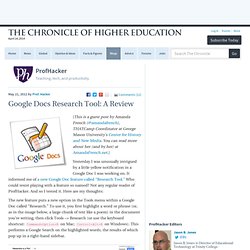
You can read more about her (and by her) at AmandaFrench.net.] Yesterday I was unusually intrigued by a little yellow notification in a Google Doc I was working on. It informed me of a new Google Doc feature called “Research Tool.” Free audiovisual learning opportunities « L&T blog: About learning, training and technology at ITC-ILO. The open and free audiovisual opportunities to learn are growing exponentially on the internet.
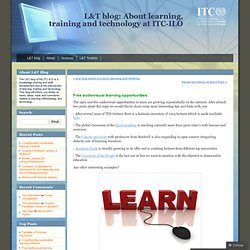
After already two posts about this topic we would like to share some more interesting tips and links with you: - After several years of TED lectures there is a fantastic inventory of 1204 lectures which is made available here. - The global classroom of the Khan Academy is reaching currently more than 3200 video’s with lessons and exercises. And then the day came, when the risk to remain tight in a bu. Student Learning Outcomes. 4Faculty.org - an innovative approach to faculty development. How to Save Time Developing Rubrics. Evaluation of the Principal. PCOT Gateway. The Rapid eLearning Blog.
Creating great interactive learning experiences requires a few core building blocks: relevant content, pull versus push, and real-world decisions.
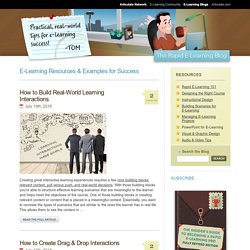
With those building blocks you're able to structure effective learning scenarios that are meaningful to the learner and helps meet the objectives of the course. One of those building blocks in creating relevant content or content that is placed in a meaningful context. Essentially, you want to recreate the types of scenarios that are similar to the ones the learner has in real life. This allows them to see the content in ... Read the full article After last week's post on the different drag & drop interaction examples, I had quite a few emails asking for tips on how to create drag and drop interactions for elearning. Sliders are used as a means to make adjustments/selections or as a simple way to navigate content. It helps to look at what others are doing to get ideas and inspiration for your own work. Division of Continuing Studies Moodle.
Student-centred learning: What does it mean for students and lecturers? Printer friendly version in PDF Introduction The term student-centred learning (SCL) is widely used in the teaching and learning literature.

Many terms have been linked with student-centred learning, such as flexible learning (Taylor 2000), experiential learning (Burnard 1999), self-directed learning and therefore the slightly overused term ‘student-centred learning’ can mean different things to different people. In addition, in practice it is also described by a range of terms and this has led to confusion surrounding its implementation. The concept of student-centred learning has been credited as early as 1905 to Hayward and in 1956 to Dewey’s work (O’Sullivan 2003). Flipping the Classroom – Simply Speaking – YouTube « Teaching English using web 2.0.
I recently read this post; Flipped Classrom: The Full Picture for Higher education by Jackie Gerstein, Ed.D., where I found the Youtube video embedded below.
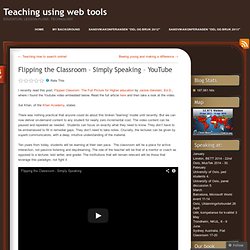
Read the full article here and then take a look at the video. Sal Khan, of the Khan Academy, states: There was nothing practical that anyone could do about this broken “learning” model until recently. But we can now deliver on-demand content to any student for nearly zero incremental cost. The video content can be paused and repeated as needed.
Pondering education, technology, and making a difference. I used to think… I used to think that giving homework the first day of school set the “tone” for our classroom, that this was an academic class that had rigor and demanded their best. Now I realize that I was trying to intimidate my students so that they would work hard and know that I was the one in charge. I used to think that compliant, well-behaved students were the ideal; now I’m afraid for them. I’m afraid for the kids who think that scoring 90% actually means something in the real world. Think You're An Auditory Or Visual Learner? Scientists Say It's Unlikely : Shots - Health Blog. iStockphoto.com We've all heard the theory that some students are visual learners, while others are auditory learners.

And still other kids learn best when lessons involve movement. But should teachers target instruction based on perceptions of students' strengths? Several psychologists say education could use some "evidence-based" teaching techniques, not unlike the way doctors try to use "evidence-based medicine. " Psychologist Dan Willingham at the University of Virginia, who studies how our brains learn, says teachers should not tailor instruction to different kinds of learners. Learning Styles - The Controversy. What is the controversy over learning styles all about?

Is the theory valid? Does it really work in the classroom, or is the claim that there is no scientific evidence for its validity the final word? We're collecting articles that call the learning styles theory a myth. We'll keep adding to it as we find interesting discussions. Weigh in. The Role of Truth, Trust and Context in Online Learning. By Sheryl Nussbaum-Beach I have been thinking today about truth, trust, and learning. I am going to try and weave them together in a post that makes some logical sense but if I fail, I ask your forgiveness in advance. Heutagogy and lifelong learning: A review of heutagogical practice and self-determined learning. Lisa Marie Blaschke Oldenburg University and University of Maryland University College (UMUC) Abstract Heutagogy, a form of self-determined learning with practices and principles rooted in andragogy, has recently resurfaced as a learning approach after a decade of limited attention.
In a heutagogical approach to teaching and learning, learners are highly autonomous and self-determined and emphasis is placed on development of learner capacity and capability with the goal of producing learners who are well-prepared for the complexities of today’s workplace. The approach has been proposed as a theory for applying to emerging technologies in distance education and for guiding distance education practice and the ways in which distance educators develop and deliver instruction using newer technologies such as social media.
The renewed interest in heutagogy is partially due to the ubiquitousness of Web 2.0, and the affordances provided by the technology. Introduction. Change.mooc.ca. Week 09: Dave Cormier. How I make time for social, networked learning « Connecting the dots. Technology for community sake #Change11.
Learning out in the Open. The leading free stock photography site. How to Use Evernote as a Blogger. A few weeks ago, I started using Evernote as my primary “blogging workbench.” It is where I store blog post ideas, collect various post components, and then write the post itself. This has proven to be a robust solution that enables me to be working on several posts simultaneously.
I thought I would share my workflow with you. Yours will be different, I’m sure. But, hopefully, this will provide you with a few ideas. If you are just getting started with Evernote, I suggest that you buy Brett Kelly’s remarkably practical e-book, Evernote Essentials, 4.0. My go through the following six steps in creating a new blog post. Set up a blogging template in Evernote. Kick Start Activity 3 (Advanced) – Add Some Muscle to your Blog. Connected Learning. Alex Ragone's Learning Blog. Weekend Reading: Reinvention Edition. Plpnetwork - home. Value Creation Stories - PLP e-Courses. Flipping Bloom’s Taxonomy.